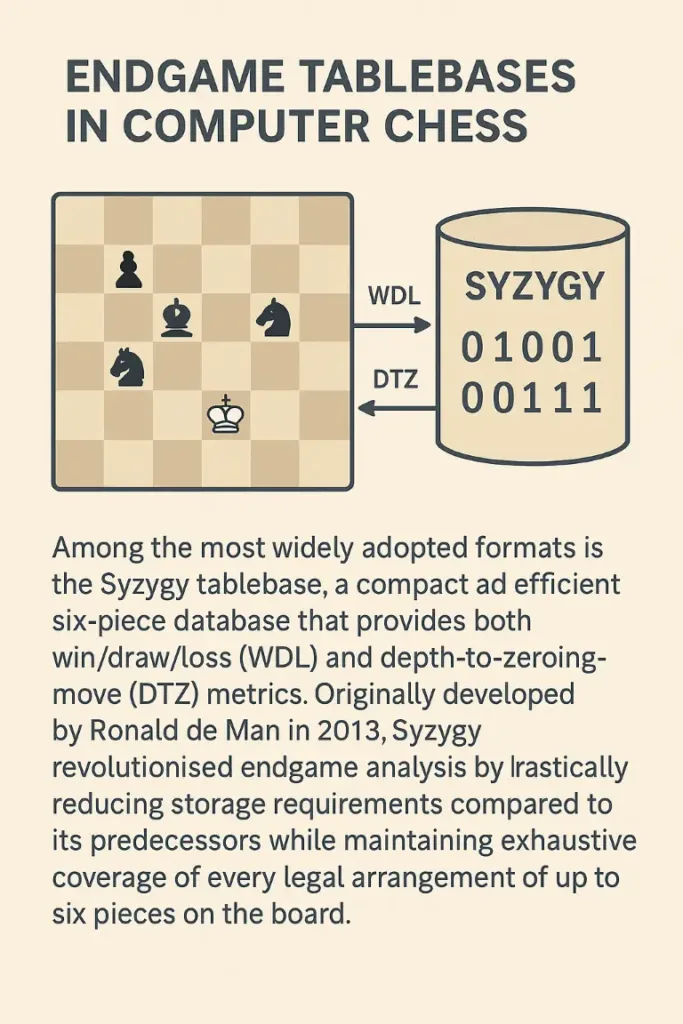Introduction Tablebases on Fritz 20
In the realm of computer chess, the study and mastery of endgames is elevated by the use of endgame tablebases—precomputed databases that contain perfect play information for positions with a limited number of pieces on the board. Among the most widely adopted formats is the Syzygy tablebase, a compact and efficient six-piece database that provides both win/draw/loss (WDL) and depth-to-zeroing-move (DTZ) metrics. Originally developed by Ronald de Man in 2013, Syzygy revolutionised endgame analysis by drastically reducing storage requirements compared to its predecessors while maintaining exhaustive coverage of every legal arrangement of up to six pieces on the board (en.wikipedia.org).
For serious players and engine enthusiasts, integrating Syzygy tablebases into a chess interface such as Fritz 20 yields immediate benefits. When enabled, top engines like Fritz, Komodo and Stockfish can play theoretically perfect endgames—saving material, avoiding the fifty-move rule, and converting minimal advantages with surgical precision. This guide provides an end-to-end walkthrough—from acquiring the Syzygy tablebase files (via ChessBase’s Endgame Turbo 5 product or free downloads) through to seamless installation and configuration in Fritz 20. We will also examine the pros and cons of using tablebases, and conclude with an objective assessment of their role in modern engine-assisted analysis.
By following this tutorial, readers will gain:
- A clear understanding of what Syzygy tablebases are and how they differ from other formats
- Step-by-step instructions for downloading and installing the databases on Windows
- Best practices for folder organisation and engine configuration in Fritz 20
- Insightful discussion on the advantages and limitations of endgame tablebases
What Are Syzygy Tablebases?
The term endgame tablebase refers to any comprehensive database that stores precomputed evaluations of chess positions with very few pieces remaining on the board. Tablebases allow engines to retrieve perfect information—whether a position is a win, loss, or draw with optimal play, and the exact number of moves to force a result under the fifty-move rule.
Origins and Development
- Nalimov Tablebases: Early pioneers in the late 1990s, but required tens of terabytes for six-piece coverage and lacked explicit fifty-move information.
- Gaviota and Lomonosov: Later formats offering seven-piece coverage but still bulky and license-restricted.
- Syzygy (2013): Introduced by Ronald de Man, Syzygy tablebases use a “two-file” system—one for WDL outcomes and another for DTZ moves—optimised under the GNU GPL v2 licence. These bases cover all legal positions with up to six pieces (143 unique endgames) on a 128 GB USB 3.0 flash drive in the commercial “Endgame Turbo 5” product (shop.chessbase.com).
Key Features
- WDL Files: Store whether a position is winning, drawing, or losing.
- DTZ Files: Provide depth-to-zeroing-move information, crucial for avoiding fifty-move draws.
- Compact Format: Achieves six-piece coverage with just tens of gigabytes, instead of terabytes.
- Open Licensing: Freely available for non-commercial use under GPL, with unrestricted probing code.
By integrating these tables, chess engines gain perfect knowledge of all six-piece endgames—transforming both engine play strength and post-game analysis quality.
Downloading the Syzygy Tablebases
The first step is to acquire the necessary Syzygy files. There are two primary avenues:
- Commercial Purchase via ChessBase’s “Endgame Turbo 5” USB flash drive
- Free Download from public Syzygy-hosting sites
Purchasing Endgame Turbo 5
ChessBase’s Endgame Turbo 5 product offers a ready-to-use USB 3.0 flash drive containing:
- 143 six-piece endgames (all possible five-piece and six-piece positions)
- 128 GB capacity to store WDL and DTZ files in a fast-loading format
The device is plug-and-play, with no manual file arrangement required—simply connect to your PC and point Fritz 20 to the drive. Pricing is €179.90 (or equivalent local currency) and orders can be placed at the ChessBase shop (shop.chessbase.com).
Free Syzygy Tablebase Downloads
If you prefer not to purchase, free six-piece Syzygy files are available online:
- Official Syzygy site (syzygy-tables.info) hosts WDL and DTZ archives for six-piece sets.
- Torrent communities and mirror servers often share compressed archives for faster downloads.
Recommendation: Verify MD5/SHA1 checksums where provided to ensure file integrity.

Preparing Your System for Installation Tablebases on Fritz 20
Before diving into Fritz 20, ensure your PC meets the following prerequisites:
- Operating System: Windows 10 or later (64-bit recommended).
- Storage: At least 150 GB of free space if installing locally; otherwise, a fast USB 3.0 port for external drives.
- Fritz 20 Software: Installed and activated on your machine.
- Administrator Rights: Required to copy files into program directories.
Installing Syzygy Tablebases in Fritz 20
Fritz 20 supports direct integration of Syzygy tablebases. You can install them either from an external USB drive (Endgame Turbo 5) or from a local folder on your hard disk. Follow the steps below according to your source:
Using the ChessBase USB Drive (Endgame Turbo 5)
- Insert the USB Drive: Plug the Endgame Turbo 5 into a USB 3.0 port.
- Launch Fritz 20: Open the application and go to File → Engine Manager.
- Select Engine: Highlight your preferred engine (e.g., Fritz, Komodo) and click Properties.
- Tablebases Tab: In the engine properties window, switch to the Tablebases section.
- Add Path: Click Add, navigate to the USB drive letter (e.g.,
E:\Syzygy\), and select the folder containing WDL and DTZ files. - Save Settings: Confirm and close all dialogs. The engine will now recognise and utilise the tablebases on the fly.
This method minimises local storage usage and keeps files neatly contained on the flash drive.
Local Folder Installation
If you have downloaded free Syzygy archives or copied Turbo 5 files locally:
- Unzip Archives: Extract
.rtbwdl(WDL) and.rtbdtz(DTZ) files into a dedicated folder, e.g.,C:\ChessData\Syzygy\6pieces\. - Open Fritz 20 → Engine Manager → Properties for your engine.
- Tablebases Tab → Add → Browse to
C:\ChessData\Syzygy\6pieces\. - Reorder Paths: Ensure the newly added path is at the top if multiple tablebase sources exist.
- Apply and Exit: Engines will detect the files on next evaluation cycle.
Tip: Organise tablebase files in subfolders named by piece count (e.g., 5pieces, 6pieces) to facilitate future upgrades.

Configuring Tablebases on Fritz 20 for Optimal Performance
Beyond simple detection, you can fine-tune Fritz 20 to harness tablebases effectively:
- Maximum Distance to Zeroing Move: In Engine → Settings, set the DTZ horizon to match your tablebase depth (usually unlimited for Syzygy).
- Cache Size: Increase the engine’s hash table to at least 2 GB—this accelerates lookups into large WDL/DTZ files.
- Multi-CPU Threads: Assign additional cores to the engine for faster parallel evaluation, especially when probing DTZ tables.
Regularly update your tablebase files when newer seven-piece Syzygy sets become available, following the same installation procedure.
Pros and Cons of Using Endgame Tablebases
Integrating Syzygy tablebases into Fritz 20 elevates analytical rigour but also introduces practical considerations. Below we present an objective assessment:
Advantages
- Perfect Endgame Play: Engines never blunder in six-piece endings, ensuring accurate piece-trade decisions in earlier phases.
- Depth-to-Zeroing Insight: DTZ metrics guide engines to make pawn moves or captures, avoiding fifty-move draws.
- Faster Analysis: Precomputed evaluations reduce engine search depth requirements, saving CPU cycles.
Limitations
- Storage Requirements: Even compressed, six-piece WDL+DTZ demands tens of gigabytes; seven-piece expands this further.
- Learning Curve: Casual users may find folder management and engine settings daunting.
- Diminishing Returns: Beyond seven pieces, tablebase sizes grow exponentially, making complete coverage impractical at present.
Overall, for serious analysts and correspondence players, the benefits far outweigh the storage and setup overhead.
Conclusion
Syzygy tablebases represent a pivotal tool in modern chess computing—providing engines with theoretically perfect knowledge of six-piece endgames. By following this guide, you can seamlessly integrate these databases into Fritz 20, whether via ChessBase’s Endgame Turbo 5 USB drive or free downloads. Proper installation, coupled with judicious engine configuration, yields:
- Flawless endgame conversions
- Enhanced evaluation accuracy during the middlegame
- Insightful statistical metrics on draw horizons
However, users should be mindful of the considerable storage footprint and the incremental complexity of setup. As tablebases expand to seven pieces—and potentially beyond—maintaining local archives will demand more resources. Alternative approaches, such as cloud-based tablebase servers or selective piece-count installations, may alleviate these concerns.
Looking forward, as engine designers push the boundaries (e.g., DeepSeekT with unrestricted probing), the realm of perfect play will extend deeper into the middlegame, blurring the lines between human creativity and algorithmic precision. Nonetheless, for the foreseeable future, Syzygy tablebases remain the gold standard for endgame mastery—empowering players and engines alike to explore, learn, and perform at the highest echelons of chess proficiency.
References
- “Endgame tablebase.” Wikipedia. (en.wikipedia.org)
- “Endgame Turbo 5 USB flash drive.” ChessBase Shop. (shop.chessbase.com)

Jorge Ruiz Centelles
Filólogo y amante de la antropología social africana